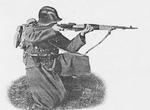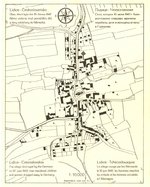
Czechoslovakia
| Full Name | 25 Czecho-Slovak Republic | |
| Alliance | Axis - Minor Member Nation or Possession | |
| Possessing Power | Germany | |
| Entry into WW2 | 1 Sep 1939 | |
| Population in 1939 | 15,300,000 | |
| Military Deaths in WW2 | 25,000 | |
| Civilian Deaths in WW2 | 320,000 | |
| - Civ Deaths from Holocaust | 277,000 |
Contributor: C. Peter Chen
ww2dbaseCzechoslovakia was founded in Oct 1918 at the end of WW1, carved out of the defeated Austro-Hungarian Empire, inheriting some of Austria-Hungary's heavy industries. In the 1930s, as the Nazi Party gained power in Germany, the ethnic Germans in Czechoslovakia began aligning themselves toward their mother country, which added to the already-present ethnic tension between the majority Czech and minority Slovak populations.
ww2dbaseIn 1938, German ambition fell on Czechoslovakia. Using the ethnically-German northwestern regions of Czechoslovakia (which the Germans called Sudetenland) as an excuse, Germany asserted unreasonable demands. Hitler's original intention was to create the situation where Czechoslovakia would be unable to accept the demands, thus allowing the German Army an excuse to march on Prague, but appeasement efforts from British leaders Neville Chamber and French leader Édouard Daladier ended up forcing Czechoslovakia to accept a German annexation of Sudetenland in Oct 1938 per results of the Munich Conference. Even before the Germans had fully occupied the newly gained territory, however, Germany already initiated a new round of intrigues and military preparations to try taking all of Czechoslovakia once again, this time attempting to divide Czechoslovakia from the inside, funding the independence movements of various nationalist groups.
ww2dbaseIn early Mar 1939, Czechoslovakian President Emil Hácha began to clamp down on the various nationalist groups, and Germany was forced to move up its timetable. Slovakia and Ruthenia were forced by Germany to proclaim independence, while Hácha was bullied into submission. Czechoslovakia ceased to be a sovereign nation on 15 Mar; the western portion became a German protectorate, the eastern portion divided up between the newly proclaimed Slovakia and Hungary, while Poland took a small piece of territory in the fray as well.
ww2dbaseIn occupied Sudetenland, ethnic Germans were generally cooperative with the new occupation administration. In fact, skilled in the Czech language, many were employed by the Germans in other portions of occupied Czechoslovakia. Czechs and Slovakians, though considered a lower class than Germans in Nazi philosophy, were considered candidates to be Germanized. Jews in the former Czechoslovakia, however, suffered the same fate as Jews in other German-occupied countries; almost all of the Jews who were unable to flee the country were deported to concentration camps or ghettos, and only a few thousand survived in hiding. The Czechoslovakian economy was exploited immediately after occupation as Germany artificially maintained a favorable exchange rate with the Czechoslovakian currency, thus bringing in large quantities of consumer goods into Germany. The thriving Czechoslovakian pre-war armaments industry remained in operation after the German occupation began, albeit under German supervision, to supply the Germany Army with tanks, small arms, and field guns. As the war went on, the German industries were pressured more and more; to alleviate this, an estimated 350,000 Czechoslovakians were sent to Germany to serve as forced laborers, serving beside forced laborers of other nationalities.
ww2dbaseThere were many resistance groups in the former Czechoslovakia, but the largest were the Obrana národa (coalition of many smaller groups willing to cooperate with the military command of the Czechoslovakian government-in-exile), the Politické ústredà (politicians sympathetic to Edvard Benes), Peticnà vybor Verni zustaneme (social democrats and leftists), and the Communist Party of Czechoslovakia. The most successful resistance operation was the assassination of Reinhard Heydrich, the Protector of Bohemia and Moravia, which led to brutal reprisals that saw the complete destruction of the villages of Lidice and Lezáky; though this particular episode of reprisal was severe, it was not unlike how events typically unfolded after successful partisan operations. Through out the war, these groups gathered intelligence for both the Western Allies and the Soviet Union.
ww2dbaseDuring the war, thousands of ethnic Czechs and Slovakians fought for the Western Allies. Early in the war, a Czechoslovakian branch was formed under the French Army, with its 1st Infantry Division seeing action in the German invasion of France. Later in the war, as many made their way to the United Kingdom, many Czechoslovakians joined the British military and fought in North Africa, Middle East, and Europe; the No. 310 Squadron of the British Royal Air Force, active participants of the Battle of Britain, was famously all-Czech.
ww2dbaseOn 4 Apr 1945, near the end of the European War, a provisional Czechoslovakian government was formed in Kosice in the Slovak Republic, sponsored by the Soviet Union; on the same day, Red Army troops entered Bratislava. On 5 May, a national uprising began in Prague, and the newly formed Czech National Council found itself as the leader of the uprising, fighting against the 40,000 German occupation troops in the former capital city. On 8 May, German troops in the former Czechoslovakia surrendered, and Soviet troops entered Prague on the following day.
ww2dbaseAfter the war, Czechoslovakia was restored as a sovereign nation, although its territory had shrunken after Subcarpathian Ruthenia was forcefully taken by the Soviet Union and given to Ukraine. Anti-Axis sentiment in the country ran rampant during the period immediately after the war. Ethnic Germans and ethnic Hungarians who accepted German or Hungarian citizenship during the war lost their Czechoslovakian citizenship and were forcefully deported; while some ethnic Hungarians had their citizenship restored by 1948, the ethnic Germans were never given such forgiveness, and as a result about 1,600,000 ethnic Germans were deported to the American-occupied zone of Germany and about 750,000 to the Soviet-occupied zone. Somewhere between 20,000 to 250,000 ethnic Germans died during this period, most from starvation and illness, but there were reports of many murders and suicides. Ethnic Germans who were known to be resistant to the occupation, those who worked in key industries, and those who married ethnic Czechs or Slovakians were allowed to remain in the newly reformed nation. In 1948, the Third Republic was removed from power, and Czechoslovakia entered a communist era that lasted until 1989. On 1 Jan 1993, Czechoslovakia was divided into two nations, the new Czech Republic in the west and the restored Slovak Republic in the east (sometimes Second Slovak Republic, to differentiate from the 1939-1945 German-sponsored First Slovak Republic).
ww2dbaseSources:
William Shirer, The Rise and Fall of the Third Reich
Wikipedia
Last Major Update: Apr 2011
| People | ||
| Beneš, Edvard | Frantisek, Josef | Hácha, Emil |
| Catlos, Ferdinand | Haas, Pavel | Tiso, Jozef |
| Frank, Karl | Henlein, Konrad | Tuka, Vojtech |
| Events Taken Place in Czechoslovakia | ||
| Munich Conference and the Annexation of Sudetenland | 29 Sep 1938 - 10 Oct 1938 | |
| Dismemberment of Czechoslovakia | 14 Mar 1939 - 17 Mar 1939 | |
| The Slovak-Hungarian War | 23 Mar 1939 - 31 Mar 1939 | |
| Lidice Massacre | 9 Jun 1942 - 10 Jun 1942 | |
| Discovery of Concentration Camps and the Holocaust | 24 Jul 1944 - 29 Apr 1945 | |
| Slovak National Uprising | 29 Aug 1944 - 28 Oct 1944 | |
| Prague Strategic Offensive | 6 May 1945 - 11 May 1945 | |
| Aircraft | ||
| B-534 | ||
| Vehicles | ||
| Jagdpanzer 38(t) | PzKpfw 38(t) | |
| Weapons | ||
| 10.5 cm hrubĂ˝ kanon vz. 35 Field Gun | ZB-53 vz. 37 Machine Gun | |
| CZ vzor 38 Handgun | ZB-60 Machine Gun | |
| K4 Field Gun | ZH-29 Rifle | |
| ZB vz. 24 Rifle | ZK-383 Submachine Gun | |
| ZB vz. 26 Machine Gun | ||
| Facilities | ||
| Plzen Skoda Works Complex | Factory | |
| Theresienstadt Concentration Camp | Prison Camp | |
Photographs
 |  |
 |
Czechoslovakia in World War II Interactive Map
Did you enjoy this article or find this article helpful? If so, please consider supporting us on Patreon. Even $1 per month will go a long way! Thank you. Share this article with your friends: Stay updated with WW2DB: |
Visitor Submitted Comments
18 Mar 2016 11:37:18 AM
Do you have any information regarding a plane factory in Czechoslovakia near the end of the war.?
Named brat? Woman from auswitz were moved to the factory.
Any information will be helpful.
Thank you!
10 Apr 2017 11:31:23 AM
any infor on u.s. control of Kraslice (graslitz) 1945-1946. what companies were involved.
20 Jun 2017 05:57:01 PM
I am doing Czechoslovakia.
15 Feb 2019 01:48:38 PM
Have some old photos of U.S. Army personnel in Graslitz and German army personnel and vehicles leaving there at close of war. My uncle was in 1st Infantry Div., CIC and took photos.
23 Jan 2023 07:35:40 AM
Thank you very much this article was very informative. I'm a proud Czech living in Canada, and when told to do a WW2 project for school this was my go-to choice. For any looking for further history, I'd recommend the podvast Dejiny Prvni Republiky, for years 1920-1939, and the leadup to the Nazi invasion. Nazdravi!
All visitor submitted comments are opinions of those making the submissions and do not reflect views of WW2DB.
- » WW2DB's 19th Anniversary (29 Dec 2023)
- » Looted Painting "Madonna with Child" Returned to Poland (2 Jun 2023)
- » Wreck of USS Mannert L. Abele Found (29 May 2023)
- » Wreck of Montevideo Maru Found (25 Apr 2023)
- » Accidental Detonation of a WW2-Era Bomb in Great Yarmouth (10 Feb 2023)
- » See all news
 |  |
- » 1,146 biographies
- » 337 events
- » 43,422 timeline entries
- » 1,237 ships
- » 349 aircraft models
- » 207 vehicle models
- » 372 weapon models
- » 123 historical documents
- » 259 facilities
- » 468 book reviews
- » 28,395 photos
- » 432 maps
Winston Churchill, on the RAF
29 May 2012 01:34:05 AM
You forgot to mention - Slovak National Uprising - where Slovak army forces for 2 months fought against german army and then continued with guerilla war. It was huge operation and they were in the middle of german forces in 1944: http://en.wikipedia.org/wiki/Slovak_National_Uprising